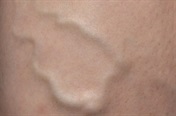
Most people taking part in sports suffer injury at some point. Find out here which injuries are common, and how they can be prevented and treated.
Description
This refers to swelling of the soft tissues of the feet and ankles - the bones are not enlarged.
Comments
Swelling may be due to different mechanisms, and may affect one or both feet. It is common in the elderly, pregnant women, and in certain occupations. It may also be a sign of organ failure.
Symptoms and signs
Patients report difficulty putting on socks and shoes, and may have discomfort from the stretched skin due to the swelling. Feet feel heavy and clumsy.
Examination may reveal swelling even beyond the ankles, sometime up to the knees. A feature often seen is “pitting oedema” - a finger pressed firmly into the swollen flesh for 10-20 seconds will leave a clear pit, which may take 10 minutes or more to smooth out again. This is due to fluid being displaced by the fingertip, and shows how waterlogged the tissues are. The delay in restoring the skin to normal demonstrates the sluggish fluid movement in the tissues.
Causes
Swelling may be due to local causes, such as
- Injury to the foot or ankle - including recent surgery
- Infection
- Burn wounds
- Insect bites or stings
- Arthritis of joints of the foot or ankle, including gout
Regional conditions - those affecting the leg - which can lead to ankle swelling include
- Deep vein thrombosis (clot)
- Varicose veins
- Prolonged sitting (such as during long flights)
- Excessively tight clothing
- Damage to the lymphatic system - trauma, infection or congenital abnormalities.
General conditions associated with ankle swelling include
- Pregnancy- the large uterus acts as a mechanical obstruction, partly blocking the main leg veins where they join the abdominal veins. This causes increased back pressure, making fluid leak out of the veins. This fluid collects, by gravity, around the ankles.
- Obesity
- Advanced age
- Prolonged standing - as found in some occupations
- Malnutrition
- Hypothyroidism - can cause particular swelling of the front of the lower leg, including the ankles.
Organ failure can also cause ankle swelling
- Heart failure results in fluid accumulation (by gravity) when the heart can no longer effectively pump fluids around the body. Fluid seeps out of the blood vessels and settles in the tissues, causing them to swell.
- Liver failure produces jaundice, but also causes fluid accumulation in body cavities (such as the abdomen). The overall increase in fluid, plus the pressure caused by a swollen belly, together result in swollen ankles.
- Kidney failure means the body cannot get rid of excess fluids. As this builds up, it will show first in areas most affected by gravity, such as the feet and ankles.
Some drugs cause ankle swelling as a side effect, such as:
- Calcium channel blockers - these are used for lowering blood pressure. They are very effective, but nearly always cause swelling of the feet and ankles
- Steroids and steroid hormones, like oestrogen (found in contraceptive pills) and testosterone.
- Some anti-depressants
Diagnosis
Much will depend on what is found on examination. Signs of underlying problems will provide a working diagnosis of the cause, and special tests will confirm this. Tests often done here include
- Full blood count - for anaemia, infection, malnutrition
- Clotting tests - for suspected deep vein thrombosis (DVT)
- Blood electrolytes and kidney function tests
- Liver function test
- ECG and chest X-ray for heart failure
- X-rays of the feet and ankles for arthritis problems
- Special blood tests for auto-immune disease - such as rheumatoid arthritis
- Tests for gout
Treatment
Wherever possible, underlying causes must be treated. This may include specialist treatment of heart or kidney disease. Where the problem is due to medication, the treatment must definitely not just be stopped. The patient’s condition must be re-evaluated, with a view to changing to another form of treatment. This must only be done under medical supervision, because it may have serious consequences, such as in the case of depression or heart failure.
General measures may include the use of
- diuretics (where appropriate) to reduce the total fluid load
- wearing support stockings
- lying down with feet slightly elevated whenever possible
- reducing salt intake
- increasing mobility - more walking
With ankle swelling, any signs of chest pain or sudden shortness of breath could be serious, and could indicate a pulmonary embolism, and emergency attention is needed.
Outcome
This will depend on adequate management of the underlying cause. In some cases, especially when the swelling has been present for many years, complete reversal is not possible. Those with congenital lymph drainage problems never improve, and the ankles and even lower legs may become permanently enlarged, with firm, rubbery tissues.




 Publications
Publications
 Partners
Partners












